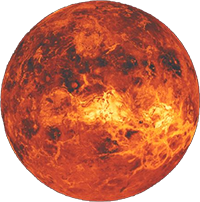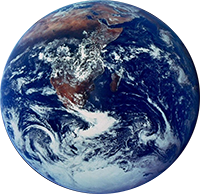The Inner Planets
The four inner or terrestrial planets have dense, rocky compositions, few or no moons, and no ring systems. They are composed largely of refractory minerals, such as the silicates, which form their crusts and mantles, and metals such as iron and nickel, which form their cores. Three of the four inner planets (Venus, Earth and Mars) have atmospheres substantial enough to generate weather; all have impact craters and tectonic surface features such as rift valleys and volcanoes. The term inner planet should not be confused with inferior planet, which designates those planets that are closer to the Sun than Earth is (i.e. Mercury and Venus).
Mercury

Mercury speeds around the sun every 88 days, traveling through space at nearly 50 km (31 miles) per second -- faster than any other planet. One Mercury solar day equals 175.97 Earth days.
Mercury's elliptical orbit takes the small planet as close as 47 million km (29 million miles) and as far as 70 million km (43 million miles) from the sun. If one could stand on the scorching surface of Mercury when it is at its closest point to the sun, our star would appear more than three times as large as it does when viewed from Earth. Because Mercury is so close to the sun, it is hard to directly observe from Earth except during twilight.
Mercury makes an appearance indirectly, however -- 13 times each century, Earth observers can watch Mercury pass across the face of the sun, an event called a transit. The transits fall within several days of May 8 and November 10. The first two transits of Mercury in the 21st century occurred 7 May 2003 and 8 November 2006. The next will occur on 9 May 2016.
Venus

Venus and Earth are similar in size, mass, density, composition and gravity. There, however, the similarities end. Venus is covered by a thick, rapidly spinning atmosphere, creating a scorched world with temperatures hot enough to melt lead and a surface pressure 90 times that of Earth.
The Venusian year (orbital period) is about 225 Earth days long, while the planet's sidereal rotation period is 243 Earth days, making a Venus solar day (measured noon to noon) about 117 Earth days long. Resulting from this slow rotation Venus cannot generate a magnetic field similar to Earth's -- though its core iron content is similar to that of the Earth. (Venus' iron core is approximately 3,000 km [1,900 miles] in radius.) Venus rotates retrograde (east to west) compared with Earth's prograde (west to east) rotation. Seen from Venus, the sun would rise in the west and set in the east.
Because of its proximity to Earth and the way its clouds reflect sunlight, Venus appears to be the brightest planet in the sky. Although we cannot normally see through Venus' thick atmosphere, NASA's Magellan mission to Venus during the early 1990s used radar to image 98 percent of the surface, and the Galileo spacecraft used infrared mapping to view mid-level cloud structure as it passed by Venus in 1990 on its way to Jupiter.
Earth

Earth, our home planet, is the only planet in our solar system known to harbor life: life that is incredibly diverse. All the things we need to survive exist under a thin layer of atmosphere that separates us from the cold, airless void of space.
Earth is made up of complex, interactive systems that create a constantly changing world that we are striving to understand. From the vantage point of space we are able to observe our planet globally, using sensitive instruments to understand the delicate balance among its oceans, air, land and life. Satellite observations help study and predict weather, drought, pollution, climate change and many other phenomena that affect the environment, economy and society.
Earth is the third planet from the sun and the fifth largest in our solar system. Earth's diameter is just a few hundred kilometers larger than that of Venus.
Mars

Though details of Mars' surface are difficult to see from Earth, telescope observations show seasonally changing features and white patches at the poles. For decades, people speculated that bright and dark areas on Mars were patches of vegetation, that Mars could be a likely place for life-forms and that water might exist in the polar caps. When the Mariner 4 spacecraft flew by Mars in 1965, many were shocked to see photographs of a bleak, cratered surface. Mars seemed to be a dead planet. Later missions, however, have shown that Mars is a complex member of the solar system and holds many mysteries yet to be solved.
Mars is a rocky body about half the size of Earth. As with the other terrestrial planets -- Mercury, Venus and Earth -- the surface of Mars has been altered by volcanism, impacts, crustal movement, and atmospheric effects such as dust storms.
Mars often appears reddish due to a combination of the fact that its surface is comprised of iron-rich minerals that essentially rust (or oxidize) and that the dust made of these minerals is kicked up into the atmosphere, giving the atmosphere a reddish hue as well.





